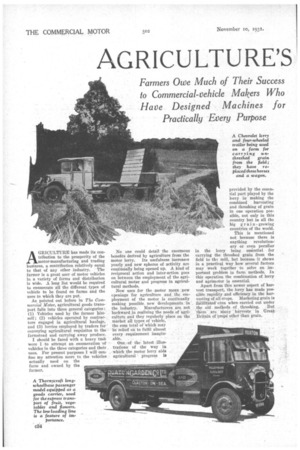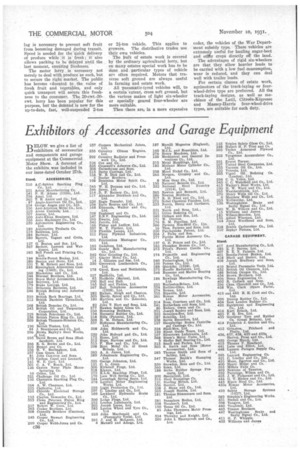AGRICULTURE'S
Page 56

Page 57

Page 58

If you've noticed an error in this article please click here to report it so we can fix it.
GREATEST AID
Farmers Owe Much of Their Success to Commercial-vehicle Makers Who Have Designed Machines for Practically Every Purpose
AGRICULTURE has made its contribution to the prosperity of the motor-manufacturing and trading business, a contribution relatively equal to that of any other industry. The farmer is a great user of motor vehicles in a variety of forms and distribution is wide. A long list would be required to enumerate all the different types of vehicle to be found on farms and the uses to which they are put.
As pointed out before in The Commercial Motor, agricultural goods transport falls into three general categories: (1) Vehicles used by the farmer him. self ; (2) vehicles operated by eontrae-. tors engaged in agricultural haulage, and (3) lorries employed by traders for ' conveying agricultural requisites to the . farmstead and carrying away produce.
I should be faced with a heavy 'task were I to attempt an enumeration of ' vehicles in the three categories and their , uses. For present purposes I will confine my attention more to the vehicles actually used on the farm and owned by the farmer.
No one could detail the enormous benefits derived by agriculture from the
motor lorry. Its usefulness increases yearly and new spheres of activity are continually being opened up. A kind of reciprocal action and inter-action goes on between the employment a the agricultural moter and progress in agricultural methods.
New uses for the motor mean tiew cpenings for agriculture and the employment of the motor is continually making possible new developments, in the industry. Manufacturers are not backward in realizing the needs of agriculture and they regularly place on the market all types of vehicle, the sum total of 'which may • be relied eu to fulfil almost every requirement imaginable.
One. of the latest illustrations of the way in which the motor lorry aids agricultural progress is
provided by the essential part played by the lorry in making the combined harvesting and threshing of grain in one operation possible, not only in this country but in all the big grain-growing countries of the world.
This is mentioned not because there is anything revolutionary or even peculiar in the lorry being essential for carrying the threshed grain from the field to the mill, but because it shows in a practical way how several factors may work together to solve an important problem in farm methods. In this operation the combination of lorry and agrimotor is essential.
Apart from this newer aspect of harvest transport, the lorry has made possible rapidity and efficiency in the harvesting of all crops. Marketing grain is ia'ciIitated-eien when carried out under
the old methods of threshing, But there are ' ninny harvests in 'Great Britain of crops' other than grain. Take the potato erop as an example. Here, in the harvesting season, which lasts over a long period of summer and early autumn, thousands of lorries ma:' be seen hauling the crop from the field to market or to the clamp, and again, later in the season, from the clamp to market.
There is the sugar-beet harvest lasting from September to January. It iFt safe to say that many agriculturists who have been sucessful in growing the crop would never have realized its full values had it not been for the use of the motor lorry in transferring the roots to the factory. Certainly many people could not have grown the crop at all but for the solution of the transport problem by the road vehicle. • 'Road transport has conferred an inestimable boon on every class of livestock breeder and feeder, from the
dealer in ordinary commercial stock to the breeder of pedigree stock andthe feeder. On the one hand it saves labour, anxiety and expense and on the other fatigue and resulting loss in the condition of the animals.
Livestock transport is an important aspect. of stock farming and it has many phases. In some of the bigbreeding
and feeding areas contractors have built up substantial businesses in livestock transport alone and the vehicles used by them for the' higher class of work are particularly fine.
Contractors' businesses are similarly built up in connection with every important livestock market in the country. The work requires a special technique, as handling live animals is quite different from., dealing with loads of "dead" material. In the future livestock carrying is more likely to be conducted by specialist 'firms than by general goods-carrying businesses. The necessity of keeping in touch Nith the needs of this side of the industry as regards the type and size of vehicle will be obvious. ,
The ordinary farmer does not require for his Own purposes the heavier and more costly vehicles used by contrae
tors. What he needs is a more generalpurpose stock-carrying type. A farmer's vehicle, to be profitable, 'must be kept regularly at work, as in all other caSes, and in order that this object may be achieved the vehicle must be suitable for adaptation from a general-purpose to a livestock carrier. The more costly types of vehicle owned individually will be found in the 'possession of large-scale pedigree stock breeders, horse owners and i.ce-horse trainers.
The point to bear in mind in connection with livestock-carrying vehicles is that they have as yet by no means become fully employed. Despite much progress in •the development of roadtransport facilities, a large quantity of stock is still dealt with by methods that are not so satisfactoryas road transport; There is scope for a much more extended use of the livestock-carrying vehiCle in its various forms.
Road transport has gone a long way towards covering the whole of the milk industry.' On the wholesale side of distribution, vehicles are in the hands of the collectors of the supplies rather than in those of the farmers and the tank wagon, in different forms, will replace the old churn lorry as improvements are made in the collecting of milk in the producing areas.
On the retail side many farmers de liver their own milk and, in any case, the delivery van is important, especially smart new vehicles for carrying eases of bottled milk.
Transport is one of the most vital factors in modern production, particularly in the fruit and vegetable industry. Without the , facilities which road transport. provides it would be impossible to dispose of the enormous quantities of fruit, vegetables and . flowers grown every year.
Apart from special bodywork for carrying bulky loads, the fruit-grower's and vegetable-grower's lorry must be fast and well suspended. Good spring
ing is necessary to prevent soft fruit from becoming damaged .during transit. Speed is needed for the 'quick delivery of produce while it is fresh ; it also allows packing to be delayed until the last moment, ensuring freshness.
The motor lorry is necessary not merely to deal with produce as such, but to secure the right market. The public has become educated to the value of fresh fruit and vegetables, and only quick transport will secure this freshness to the consumer. The 20-cwt.-30cwt. lorry has been popular for this purpose, but the demand is now for the up-to-date, fast, well-suspended 2-ton
or 24-ton vehicle. This applies to growers. The distributive trades use their own vehicles.
The bulk of estate work is covered by the ordinary agricultural lorry, but on many estates special work has to be done and particular types• of vehicle are often required. Motors that traverse soft ground are always useful in farming and estate work.
• All pneumatic-tyred vehicles will, to a certain -extent, cross soft ground, but the various makes of light six-wheeler or specially geared four-wheeler are more suitable.
Then there are, in a more expensive crder, the vehicles of the War Department subsidy type. These vehicles are extremely useful for hauling sugar-beet and °tiler crops directly off the land.
The advantages of rigid six-wheelers are that they allow heavier loads to be carried with a low fuel consumption, wear is reduced, and they can deal well with trailer loads.
For certain classes of estate work, agrimotors of the track-laying or fourwheel-drive type are preferred. All the track-laying designs, as well as niachines of the Latil, Citroen-liegresse and Massey-Harris four-wheel-drive types, are suitable for such duty.
















































































































































